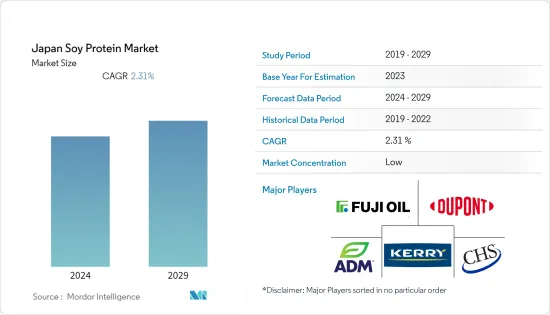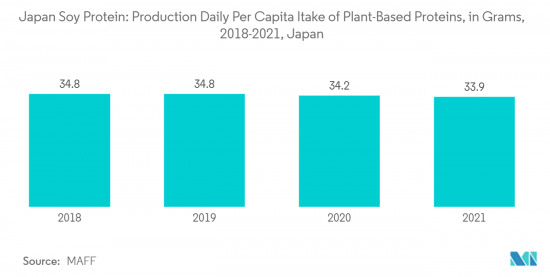PUBLISHER: Mordor Intelligence | PRODUCT CODE: 1406972

PUBLISHER: Mordor Intelligence | PRODUCT CODE: 1406972
Japan Soy Protein - Market Share Analysis, Industry Trends & Statistics, Growth Forecasts 2024 - 2029

The Japan soy protein market is expected to grow from USD 196.44 million in 2024 at a CAGR of 2.31% over the next five years.
Key Highlights
- Soy protein is used in different foods and beverages as the demand for plant-based food and beverage products is increasing in the country. Soy proteins are easily digestible and provide higher nutrients than animal meat. Owing to this, the use of soy protein in meat substitutes is increasing. Soybeans are a powerful legume that can easily replace meat as it provides a meat-like texture.
- Soy-fortified milk also observed high demand because of comparable protein, calcium, vitamins A and D, and B vitamins content to cow's milk. The demand for soy milk is increasing in the country due to rising lactose intolerance. According to JSMA data from 2022, the shipment volume of soy milk in Japan was 126.3 thousand liters. Furthermore, the demand for soy protein in sports nutrition and infant food is also increasing due to its nutritional and functional properties.
- According to the United States Department of Agriculture data from 2022, the production of soybeans in Japan was 238 thousand tons. Owing to the increasing production, the processing of soya is also increasing in the country. The market players are launching and innovating new soy proteins for a wide range of applications. For instance, Hollywood Cosmetics Japan provides a range of soy proteins for beauty and health. Soy protein is used in cosmetics and personal care products as it holds moisture in the skin for a longer time and provides glowing, healthy skin. According to Mitsubishi Chemical Corporation data from 2021, monthly household expenditure on personal care products in Japan was USD 26.96. Owing to this, the demand for soy protein in personal care products is growing. Although the use of soy protein is increasing in the country, the presence of other plant-based proteins like hemp protein, pea protein, potato protein, and others is expected to restrict the growth of the market.
Japan Soy Protein Market Trends
Increasing Demand for Plant Based Protein Products
- Consumer demand for plant-based food and beverages is increasing due to the rising trend of vegan and plant-based food consumption. Therefore, the demand for soy protein is increasing. Soy protein is used as an alternative in different dairy as well as meat alternative products. Due to rising health consciousness, consumers are opting for the consumption of less calorific and more nutritious and functional food. Also, due to the increasing prevalence of lactose intolerance, the demand for plant-based milk is increasing, which is increasing the demand for soy proteins in dairy manufacturers.
- According to Procon.Org data from 2022, 73% of people in Japan are lactose intolerant. Old consumers in the country are looking for products that are easy to digest; hence, the demand for plant-based proteins is increasing. Over the medium term, the demand for soy protein is expected to increase owing to the increasing demand for plant-based food and beverage products.

Increasing Application in Sports Nutrition
- Health-conscious consumers in the country are opting for the consumption of plant proteins as they provide more energy and keep the body fresh for a longer time. The market Players are using plant proteins like soy proteins in sports nutrition products like powders and beverages. Plant proteins reduce muscle fatigue and keep the body energized for a longer time. Additionally, soy protein helps in muscle building. Due to rising diseases like obesity and diabetes, consumers are participating in sports to keep themselves healthy.
- Sports athletes and sports enthusiasts are incorporating plant proteins in their diet regime to be fresh and fit for a longer time. According to Ministry of Internal Affairs and Communications (Japan) data from 2021, 74.79 million people in Japan are practicing sports. Owing to this, the demand for soy protein in sports nutrition products is increasing. The market players are providing soy protein products like isolates, concentrates, and others for athletes' weight management, muscle building, and overall immunity. For instance, the SAVAS brand from Meji Holdings provides soy protein for weight management.
Japan Soy Protein Industry Overview
The Japan soy protein market is fragmented, with the top companies covering major markets. The major players in this market are Archer Daniels Midland Company, CHS Inc., DuPont de Nemours Inc., Fuji Oil Group, and Otsuka Pharmaceutical Co. The demand for plant proteins is increasing in the country, due to which the market players are innovating new products. The companies are also focused on strategies like expansions, acquisitions, partnerships, and innovations to cater to growing demand.
Additional Benefits:
- The market estimate (ME) sheet in Excel format
- 3 months of analyst support
TABLE OF CONTENTS
1 INTRODUCTION
- 1.1 Study Assumptions and Market Definition
- 1.2 Scope of the Study
2 RESEARCH METHODOLOGY
3 EXECUTIVE SUMMARY
4 MARKET DYNAMICS
- 4.1 Market Drivers
- 4.1.1 Increasing Demand for Protein-Rich Food
- 4.1.2 Increasing Demand for Plant-Based and Organic Ingredients
- 4.2 Market Restraints
- 4.2.1 Presence of Alternative Proteins
- 4.3 Porter's Five Forces Analysis
- 4.3.1 Threat of New Entrants
- 4.3.2 Bargaining Power of Buyers/Consumers
- 4.3.3 Bargaining Power of Suppliers
- 4.3.4 Threat of Substitute Products
- 4.3.5 Intensity of Competitive Rivalry
5 MARKET SEGMENTATION
- 5.1 Form
- 5.1.1 Concentrates
- 5.1.2 Hydrolyzed
- 5.1.3 Isolates
- 5.2 End-User
- 5.2.1 Animal Feed
- 5.2.2 Personal Care and Cosmetics
- 5.2.3 Food and Beverages
- 5.2.3.1 Bakery
- 5.2.3.2 Beverages
- 5.2.3.3 Breakfast Cereals
- 5.2.3.4 Condiments/Sauces
- 5.2.3.5 Dairy and Dairy Alternative Products
- 5.2.3.6 RTE/RTC Food Products
- 5.2.3.7 Snacks
- 5.2.4 Supplements
- 5.2.4.1 Baby Food and Infant Formula
- 5.2.4.2 Elderly Nutrition and Medical Nutrition
- 5.2.4.3 Sport/Performance Nutrition
6 COMPETITIVE LANDSCAPE
- 6.1 Most Adopted Strategies
- 6.2 Market Share Analysis
- 6.3 Company Profiles
- 6.3.1 Royal DSM
- 6.3.2 Kerry Group PLC
- 6.3.3 Fuji Oil Group
- 6.3.4 CHS inc
- 6.3.5 DuPont de Nemours Inc
- 6.3.6 Bunge Limited
- 6.3.7 Archer Daniels Midland Company
- 6.3.8 A. Costantino & C. SpA
- 6.3.9 Mitsubishi Chemical Corporation
- 6.3.10 Cargill Inc
7 MARKET OPPORTUNITIES AND FUTURE TRENDS




